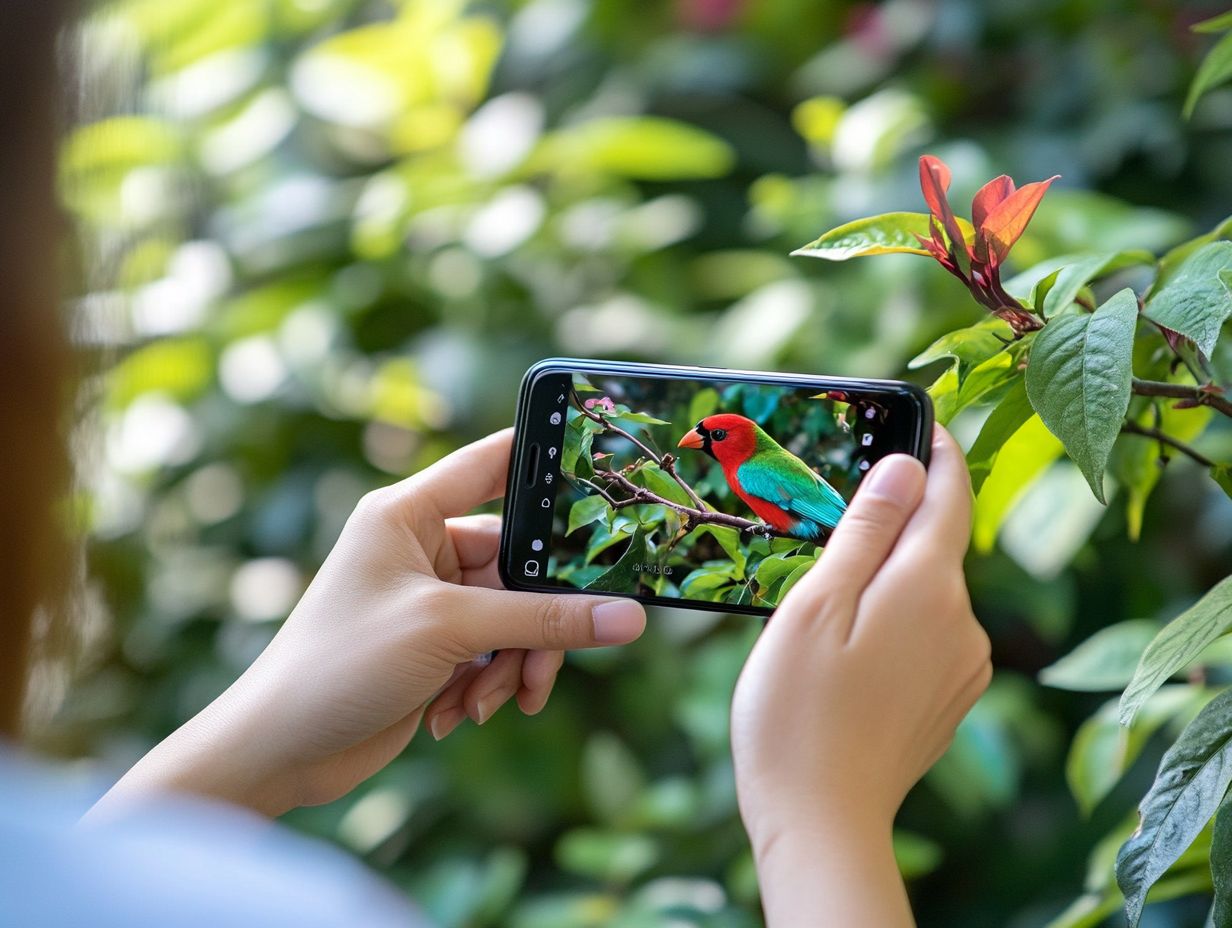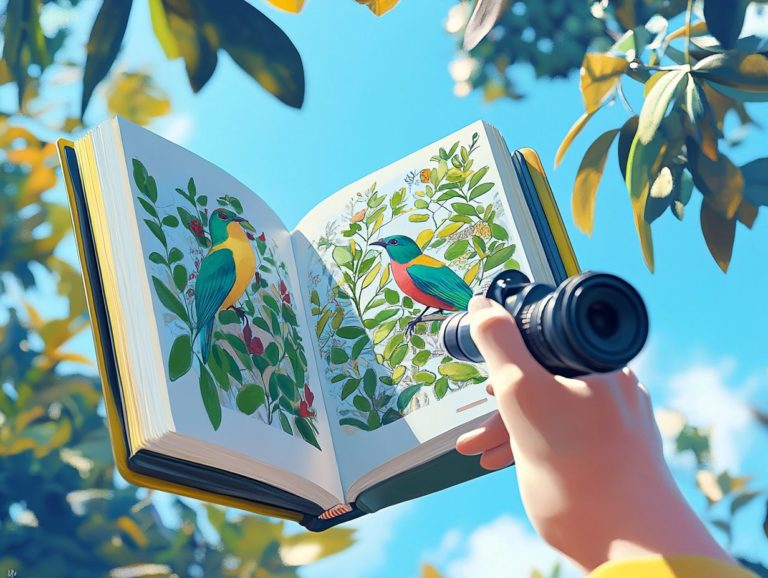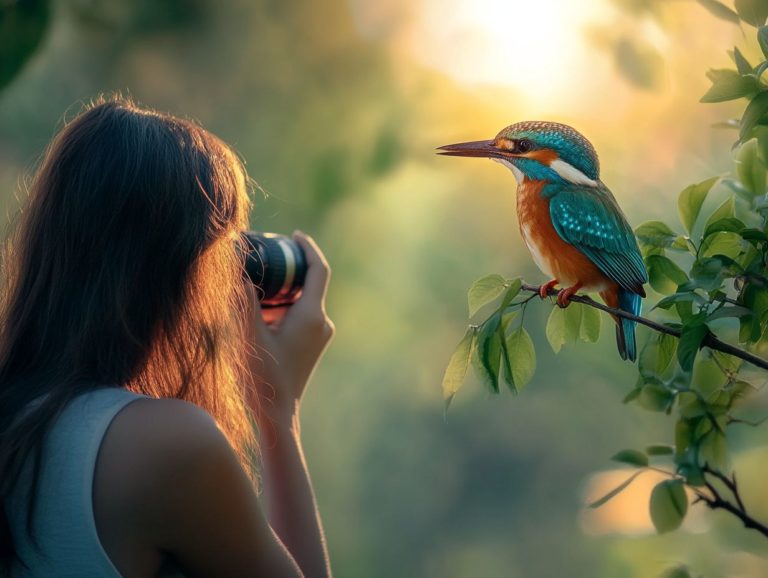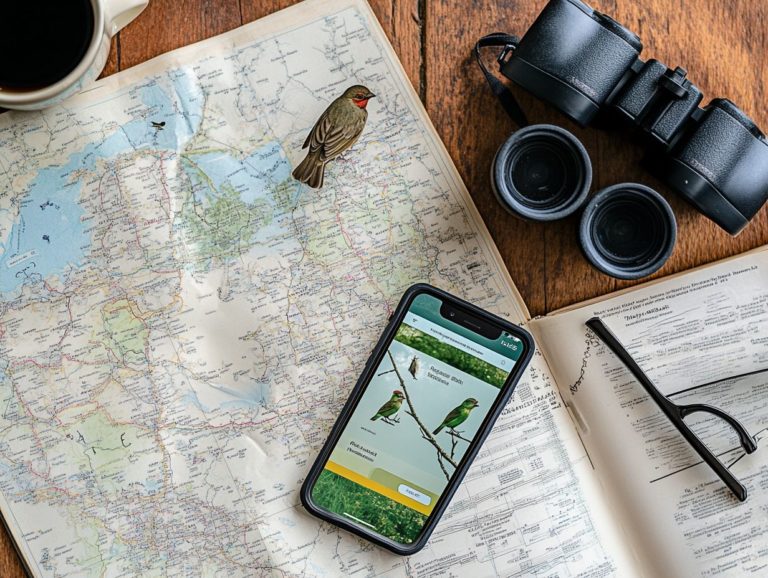Can I Use My Phone for Bird Watching?
Bird watching offers a delightful opportunity to connect with nature and immerse yourself in the avian world that surrounds you. This enhances your appreciation for wildlife.
Whether you consider yourself a seasoned bird watcher or are just dipping your toes into this captivating hobby, having the right tools like a smartphone can significantly enhance your experience.
This guide presents the essentials of bird watching, covering must-have equipment, including binoculars and a digital camera. You will also learn how to effectively utilize your smartphone to capture those fleeting moments.
From exploring camera features such as zooming and shutter speed to mastering timing and etiquette, you ll uncover the intricacies of this fascinating pursuit and its modern adaptations!
Contents
- Key Takeaways:
- The Basics of Bird Watching
- Using Your Phone for Bird Watching
- Tips for Successful Bird Watching with Your Phone
- Other Useful Tools for Bird Watching
- Frequently Asked Questions
- Can I Use My Phone for Bird Watching?
- What are some advantages of using my phone for bird watching?
- Are there any disadvantages to using my phone for bird watching?
- Do I need a specific type of phone for bird watching?
- Can I use my phone to record bird calls?
- How Can I Protect My Phone While Bird Watching?
Key Takeaways:

- Your phone can be a useful tool for bird watching with its camera and apps, but it also has limitations compared to traditional equipment.
- Choose the right location and timing to increase your chances of spotting birds with your phone. Remember to follow proper etiquette to avoid disturbing the birds.
- While your phone can be a handy tool, consider using binoculars and field guides for a more immersive and accurate bird watching experience. Online resources and communities can also provide valuable information and support.
The Basics of Bird Watching
Bird watching is a captivating outdoor pursuit that invites you to observe and study a wide array of bird species in their natural habitats. Whether you re a casual observer or a dedicated bird photographer, it offers a unique chance to connect with nature and marvel at the beauty of wildlife.
By utilizing techniques such as tracking and employing tools like binoculars and spotting scopes, you can spot everything from the vibrant Rainbow Lorikeets to the elusive Rusty Blackbirds in a variety of enchanting environments.
What is Bird Watching?
Bird watching presents an engaging outdoor activity that invites you to observe and identify a variety of bird species across diverse habitats.
This pastime captivates you with the excitement of discovering new feathered friends in their natural surroundings, whether it s in bustling urban parks or tranquil rural landscapes.
The allure lies not just in the stunning beauty and diversity of the birds themselves, but also in the peace and mindfulness it brings. As you immerse yourself in the rhythms of nature, you uncover the intricate relationships woven within ecosystems while deepening your appreciation for wildlife.
Bird watching also creates a sense of community by connecting like-minded individuals, often sparking collective efforts toward conservation. Together, you and others can protect these remarkable creatures and their habitats for generations to come.
Equipment Needed
To truly immerse yourself in the art of bird watching, having the right equipment is paramount. This includes high-quality binoculars and a dependable spotting scope, which are essential for achieving optimal viewing.
These tools allow you to catch fleeting glimpses of captivating avian behaviors and vibrant plumage details from a distance. Binoculars help you see birds up close, while spotting scopes are powerful telescopes for distant viewing.
Binoculars with a wide field of view and exceptional lens quality are particularly crucial. They enable you to spot and track fast-moving birds effortlessly.
A good spotting scope elevates the experience even further, offering greater magnification and clarity that are perfect for observing distant or elusive species.
Many enthusiasts also discover that incorporating a camera whether it s a DSLR or a smartphone adds an exciting dimension to their outings. This allows you to capture those remarkable moments.
Accessories like sturdy tripods enhance stability, ensuring your observations are clear and shake-free. Together, these elements significantly enrich your overall birding experience.
Using Your Phone for Bird Watching
With the rapid advancements in technology, smartphones have transformed into essential companions for bird watchers. These devices now boast high-quality cameras, allowing you to capture breathtaking images and videos of birds in their natural habitats. To enhance your skills, learn how to take photos while bird watching!
This enhances your experience and connection with nature.
Don t miss out on the joy of observing these stunning birds! Grab your binoculars and smartphone, and start your bird watching adventure today!
Camera Features and Apps

Smartphones with smart features have transformed bird photography, allowing you to capture stunning, high-quality images right from your device using various photography apps.
Thanks to impressive zoom capabilities, you’ll be amazed at how close you can get to observing birds in their natural habitats without causing any disturbance. This enables you to snap detailed shots from a comfortable distance. Image stabilization technology, which reduces shaky photos, further enhances the clarity of your images, minimizing blur caused by sudden movements. With high light sensitivity, you re equipped to photograph birds in a range of lighting conditions, from bright sunlight to the soft glow of twilight.
Apps like ProCamera and Camera FV-5 empower you with manual controls to fine-tune exposure and focus, maximizing the potential of your smartphone camera. Plus, post-editing with Snapseed allows you to tweak color, brightness, and detail, ensuring your images truly capture the breathtaking beauty of avian wildlife.
Benefits and Limitations
While using smartphones for birdwatching presents an array of advantages—think convenience and portability—it’s important to recognize the limitations that come along with them. Exploring tech innovations in birdwatching apps can help maximize your experience.
For many bird watchers, the ability to swiftly capture a fleeting moment without the hassle of a traditional camera setup can truly transform the experience. With user-friendly interfaces and instant photo-sharing capabilities, smartphones empower you to document your sightings effortlessly and connect with fellow enthusiasts across various social media platforms. Additionally, using apps to enhance your birdwatching skills can provide valuable resources, including bird identification tools and local sighting alerts.
However, be aware that these handheld devices often falter in low-light conditions, leading to less-than-stellar image quality. Battery life can become a concern during extended outings, especially when you’re juggling multiple apps. Plus, they generally lack the advanced features that dedicated cameras offer, which can be essential for serious bird photographers.
Tips for Successful Bird Watching with Your Phone
To truly maximize your birdwatching experience with a smartphone, you’ll want to employ a blend of strategic tips, including mastering the angles for optimal photography. Additionally, knowing the best bird watching apps can enhance your adventure. Start by choosing the right location, as the perfect spot can make all the difference.
Don t miss out timing your outings is key for success! Venture out when the birds are most active to achieve optimal results, which is typically early morning or late afternoon.
Location and Timing
Choosing the right location and timing can truly elevate your bird-watching experience, transforming it into something both productive and delightful.
Different environments play vital roles in determining which species you might observe at any given moment. Wetlands are often teeming with waterfowl and shorebirds, especially during migration seasons, while forests serve as a haven for a diverse array of songbirds and raptors. You might even find urban areas brimming with surprises, showcasing species like pigeons and sparrows that have adapted to the hustle and bustle of human life.
Early mornings and late afternoons are typically your best bets for spotting birds, as many species come alive during these hours, providing a perfect opportunity for bird photography. To enhance your chances of encountering specific birds, scout locations rich in their preferred habitats think near water sources or thick foliage. Pay attention and listen for their calls; it s like having a secret map guiding you to their hidden spots.
Proper Etiquette
Practicing proper etiquette while bird watching is essential for the well-being of wildlife and for enhancing the experience of fellow enthusiasts who share your passion for nature.
Following these simple guidelines will make your bird watching more enjoyable! It’s crucial to maintain a respectful distance from the birds, allowing them to engage in their natural behaviors without interference. Avoid making loud noises or sudden movements that might startle them; this promotes a peaceful environment for all creatures. Embracing the principle of “leave no trace” is vital; remember to take all your trash with you and avoid disturbing their habitats.
Sharing these moments with others helps cultivate a community of responsible bird watchers who appreciate nature in a conscientious and ethical manner. Don’t miss out on connecting with fellow bird lovers!
Other Useful Tools for Bird Watching

Beyond smartphones, you have access to a variety of exceptional tools that can elevate your bird watching experience. Consider incorporating high-quality binoculars for a closer look, field guides that provide valuable insights, and online resources like the science behind bird watching apps that connect you with local bird watching communities.
Binoculars and Field Guides
Binoculars and field guides are key items for you as a bird watcher, enhancing your ability to identify and observe various species in their natural habitats.
When selecting binoculars, it’s important to consider several features for the best performance during your bird watching adventures. Magnification power refers to how much closer you can see the birds; higher magnification enables you to see distant birds more clearly. The quality of the lenses is equally crucial opt for clear, fully coated optics that enhance brightness and clarity, allowing you to appreciate the subtle details of plumage.
Waterproof capabilities are vital, especially when you re out in unpredictable weather. Field guides are treasures that offer insights into different bird species, their habitats, and behavioral patterns. These guides make your bird watching fun and informative, enriching your journey into the world of birds.
Online Resources and Communities
Engaging with online resources and communities can substantially enhance your bird watching experience, offering invaluable insights and support from fellow enthusiasts. Platforms like eBird and Audubon are essential companions for tracking bird sightings, allowing you to log your observations and contribute to the collection of scientific data.
These resources provide a treasure trove of educational content that helps you refine your identification skills. By immersing yourself in online forums and communities, you can share your personal experiences, gather useful tips, and partake in lively discussions, all fostering a sense of camaraderie among bird lovers.
This shared knowledge amplifies the joy of birding and deepens your understanding of conservation efforts and bird habitats.
Frequently Asked Questions
Can I Use My Phone for Bird Watching?
Yes, you can use your phone for bird watching, but it may not be the best option.
What are some advantages of using my phone for bird watching?

Using your phone for bird watching allows you to easily take photos and videos of birds, as well as access technology in bird watching, including identification apps and bird calls.
Are there any disadvantages to using my phone for bird watching?
Yes, using a phone has some downsides. Your phone may not have the same quality zoom or focus as a dedicated camera, and it can also drain your battery quickly.
Do I need a specific type of phone for bird watching?
No, you do not need a specific type of phone. However, phones with higher quality cameras may provide better results.
Can I use my phone to record bird calls?
Yes, there are many apps available that allow you to record and identify bird calls using your phone. Just make sure to follow proper birding ethics and do not disturb the birds.
How Can I Protect My Phone While Bird Watching?
Protecting your phone while bird watching is essential. Use a waterproof case or keep it in a secure pocket or pouch.
Bring a portable charger to ensure your battery doesn’t die. This way, you can capture every moment without worry!






